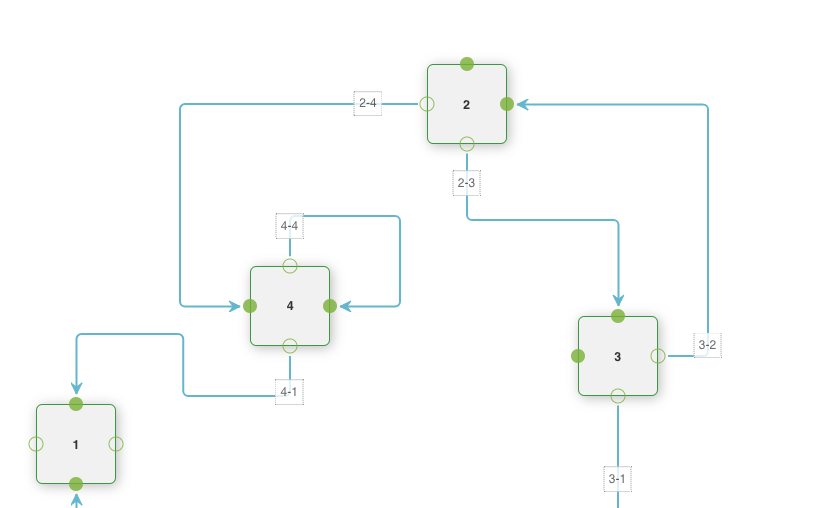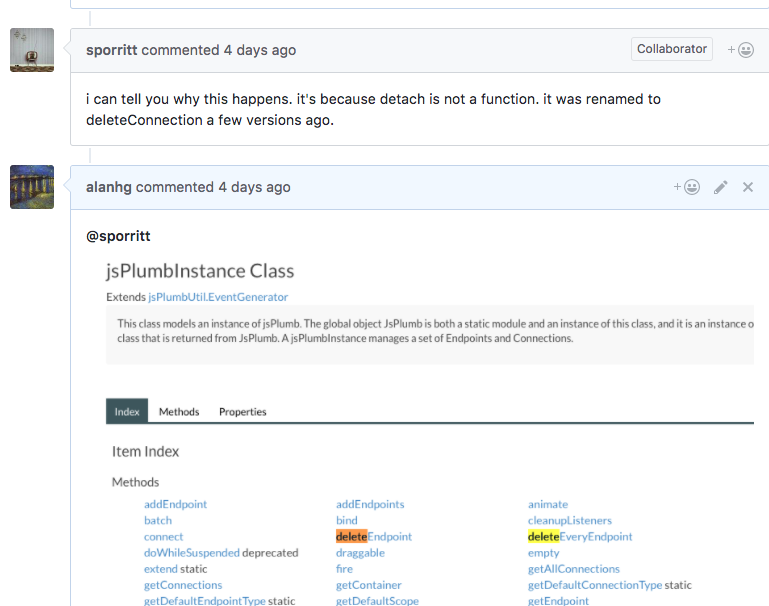jsPlumb使用指南
jsPlumb使用指南
12月 23, 2017
·
3 分钟阅读时长
·
1503
字
·
-阅读
-评论
最近项目需要实现可视化绘制DAG即有向无环图,经过几个方案的调研,最终选择了jsPlumb.
jsPlumb本身分Tookit付费版及Community社区版,因核心功能社区版都已具备,且开源社区本身的活跃度更为方便未来的开发维护等,所以选择社区版。

学习渠道
学习一个技术,官方文档,官方社区,谷歌搜索,是你最需要依重的.
这里啰嗦,贴下地址
除了这些官方资料,看一些博文也能有不小帮助,正如我这里写的,愿能帮到你些。
使用
我的实际项目前端框架是Angular,所以这里代码是是在此背景下的写法,但应不怎么影响大家去借鉴,毕竟思维,理念都差不都,毕竟都是JS。
先了解jsPlumb绘图的几个概念
端点 端点,是指,我们图上可以有几个连出去或者连进来的可视化点
锚点
锚点指的是端点可以最终落下的位置,也就意味着,一个端点,可以指定多个锚点位置,根据实际的图形位置,灵活落在某个锚点上。
连线 我们通过连接建立多个Window即节点之间的关联,比如我们用贝塞尔曲线,还是流程图那种的折线,这些就需要设定连接器
覆盖物 解决绘制与连接之上的UI问题,比如标签,或者箭头等
强调:其实,很多时候,很容易误解锚点和端点的概念,我也走了点弯路
上例子
已实现功能
- 动态添加节点
- 动态删除节点
- 动态连边
- 动态删边
- 节点拖拽监听
- 节点及边,右键菜单
第三方组件jquery.contextMenu实现
Show me the code
import {Component, ElementRef, OnInit, Renderer2, ViewChild} from '@angular/core';
declare let jsPlumb: any;
declare let $: any;
@Component({
selector: 'app-jsplumb',
templateUrl: './jsplumb.component.html',
styleUrls: ['./jsplumb.component.css']
})
export class JsplumbComponent implements OnInit {
jsPlumbInstance: any;
@ViewChild('canvas') public panel: ElementRef; // 画板
constructor(private renderer: Renderer2) {
}
ngOnInit() {
this.draw();
}
draw() {
this.jsPlumbInstance = jsPlumb.getInstance({
// default drag options
DragOptions: {cursor: 'pointer', zIndex: 2000},
// the overlays to decorate each connection with. note that the label overlay uses a function to generate the label text; in this
// case it returns the 'labelText' member that we set on each connection in the 'init' method below.
ConnectionOverlays: [
['Arrow', {
location: 1,
visible: true,
width: 11,
length: 11,
id: 'ARROW',
events: {
click: function () {
alert('you clicked on the arrow overlay')
}
}
}],
['Label', {
location: 0.1,
id: 'label',
cssClass: 'aLabel',
events: {
// connection.getOverlay("label")
tap: function () {
let label = prompt('请输入标签文字:');
this.setLabel(label);
}
}
}]
],
Container: 'canvas',
ConnectionsDetachable: true
});
const basicType = {
connector: ['Bezier', {curviness: 100}],
paintStyle: {stroke: 'red', strokeWidth: 4},
hoverPaintStyle: {stroke: 'blue'},
overlays: [
'Arrow'
]
};
this.jsPlumbInstance.registerConnectionType('basic', basicType);
// 支持拖拽
this.jsPlumbInstance.draggable('flowchartWindow1');
this.jsPlumbInstance.draggable('flowchartWindow2');
this.jsPlumbInstance.draggable('flowchartWindow3');
this.jsPlumbInstance.draggable('flowchartWindow4');
// 增加端点
this.jsPlumbInstance.addEndpoint('flowchartWindow1', sourceEndpoint);
this.jsPlumbInstance.addEndpoint('flowchartWindow2', targetEndpoint);
// listen for clicks on connections, and offer to delete connections on click.
//
this.jsPlumbInstance.bind('click', function (conn, originalEvent) {
// if (confirm("Delete connection from " + conn.sourceId + " to " + conn.targetId + "?"))
// instance.detach(conn);
// conn.toggleType('basic');
console.log(conn);
console.log(originalEvent);
});
//
this.jsPlumbInstance.bind('connection', (connInfo) => {
this.addMenu4Edge(connInfo);
console.log(connInfo);
});
this.jsPlumbInstance.bind('connectionDetached', (connInfo) => {
console.log(connInfo);
});
this.jsPlumbInstance.bind('connectionDrag', function (connection) {
console.log('connection ' + connection.id + ' is being dragged. suspendedElement is ', connection.suspendedElement, ' of type ', connection.suspendedElementType);
});
this.jsPlumbInstance.bind('connectionDragStop', function (connection) {
console.log('connection ' + connection.id + ' was dragged');
});
this.jsPlumbInstance.bind('connectionMoved', function (params) {
console.log('connection ' + params.connection.id + ' was moved');
});
this.jsPlumbInstance.bind('click', (connection, e) => {
this.jsPlumbInstance.detach(connection);
});
}
/**
* 边添加右键菜单
*/
addMenu4Edge(connInfo) {
connInfo.connection.addClass(connInfo.connection.id);
const removeEdge = (v) => {
console.log(connInfo);
let cons = this.jsPlumbInstance.getConnections('*', {source: connInfo['sourceId'], target: connInfo['targetId']});
this.jsPlumbInstance.deleteConnection(cons[0]);
};
$.contextMenu({
selector: '.' + connInfo.connection.id,
callback: function (key, opt, event) {
console.log(`event`);
console.log(event);
},
items: {
'cut': {
name: '删除',
icon: 'cut',
callback: function (key, opt) {
removeEdge(key);
}
}
}
});
}
/**
* node添加右键菜单
* id=nodeProgram-5
*/
addMenu4Node(nodeId: string) {
let removeNode = (v) => {
this.jsPlumbInstance.remove(nodeId);
};
$.contextMenu({
selector: '#' + nodeId,
callback: function (key, opt, event) {
console.log(`event`);
console.log(event);
},
items: {
'cut': {
name: '删除',
icon: 'cut',
callback: function (key, opt) {
removeNode(key);
}
}
}
});
}
addNode() {
// 图表添加节点信息
const div = this.renderer.createElement('div');
div.id = 'flowchartWindow5';
div.innerHTML = `<strong>结束5</strong><br/><br/>`;
div.setAttribute('class', 'window jtk-node');
this.renderer.appendChild(this.panel.nativeElement, div);
this.jsPlumbInstance.addEndpoint('flowchartWindow5', sourceEndpoint);
// 支持拖拽,拖拽
this.jsPlumbInstance.draggable($(div), {
drag: function (event) {
console.log(event);
},
start: function (event) {
console.log(event);
}
});
// 右键菜单
this.addMenu4Node(div.id);
}
/**
* 删除边
*/
removeEdge() {
let cons = this.jsPlumbInstance.getConnections('*', {source: 'flowchartWindow1', target: 'flowchartWindow2'});
this.jsPlumbInstance.deleteConnection(cons);
}
}
const anchors = [[1, 0.2, 1, 0], [0.8, 1, 0, 1], [0, 0.8, -1, 0], [0.2, 0, 0, -1]];
const connectorPaintStyle = {
strokeWidth: 2,
stroke: '#61B7CF',
joinstyle: 'round',
outlineStroke: 'white',
outlineWidth: 2
},
// .. and this is the hover style.
connectorHoverStyle = {
strokeWidth: 3,
stroke: '#216477',
outlineWidth: 5,
outlineStroke: 'white'
},
endpointHoverStyle = {
fill: '#216477',
stroke: '#216477'
},
// the definition of source endpoints (the small blue ones)
sourceEndpoint = {
endpoint: 'Dot',
paintStyle: {
stroke: '#7AB02C',
fill: 'transparent',
radius: 7,
strokeWidth: 1
},
isSource: true,
connector: ['Flowchart', {stub: [40, 60], gap: 10, cornerRadius: 5, alwaysRespectStubs: true}],
connectorStyle: connectorPaintStyle,
hoverPaintStyle: endpointHoverStyle,
connectorHoverStyle: connectorHoverStyle,
dragOptions: {},
overlays: [
['Label', {
location: [0.5, 1.5],
label: 'Drag',
cssClass: 'endpointSourceLabel',
visible: false
}]
]
},
// the definition of target endpoints (will appear when the user drags a connection)
targetEndpoint = {
endpoint: 'Dot',
paintStyle: {fill: '#7AB02C', radius: 7},
hoverPaintStyle: endpointHoverStyle,
maxConnections: -1,
dropOptions: {hoverClass: 'hover', activeClass: 'active'},
isTarget: true,
overlays: [
['Label', {location: [0.5, -0.5], label: 'Drop', cssClass: 'endpointTargetLabel', visible: false}]
]
};
总结
jsPlumb相对其它绘图方案已经成熟,如果不想自己重新造轮子,使用这个可以满足所需,当然实际使用上,个人认为官方Doc还是不算完善,有时看的莫名其妙,有时还有错误。
比如删边,其实函数名称叫deleteConnection,如下图:


